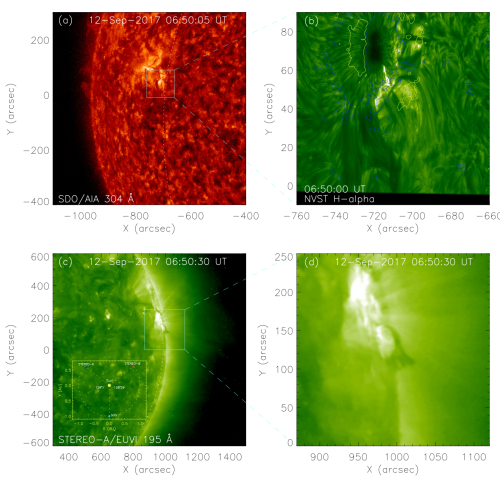Dr. WANG Jincheng and his collaborators from Yunnan Observatories, Chinese Academy of Sciences (CAS), utilized data from the one-meter New Vacuum Solar Telescope (NVST) as well as other space telescopes to conduct a detailed study on the precursors and eruption process of solar filament eruptions, exploring the onset mechanisms of filament eruptions in solar active regions. Their research findings, titled "Onset mechanism of an inverted U-shaped solar filament eruption revealed by NVST, SDO, and STEREO-A observations" were recently published in Astronomy and Astrophysics.
Solar filaments, consisting of dense and cool plasma material suspended in the extremely hot corona, are common and spectacular features on the Sun. Their eruptions often lead to the generation of solar storms, such as solar flares, coronal mass ejections, and large-scale solar oscillations. Understanding the filaments or prominences in the corona is a main subject in solar physics, including their formation, stability, eruption, magnetic field structures, among other aspects. How solar filaments become destabilized leading to intense eruptions has been a question without a unified answer.
The team focused on the eruption process of the inverted U-shaped filament in active region NOAA 12680 on September 12, 2017. Utilizing observational data from the NVST telescope, SDO, and STEREO-A, they studied the relevant physical processes preceding the eruption and to explore its onset mechanism from two observational perspectives.
The researchers found that two filament-like jet activities occurred before the eruption of the inverted U-shaped filament, both exhibiting characteristics of untwisting motion. During these two jet-like activities, Y-shaped brightenings, newly emerging magnetic flux accompanied by magnetic cancellation, and the formation of newly moving fibrils were identified. Based on these observational features, researchers concluded that the two filament-like jet activities were caused by magnetic reconnection between the newly emerging magnetic flux and the background open magnetic field, resulting in the release of the filament-confined magnetic field.
Approaching the eruption of the filament, outflows were observed being ejected from the brightenings associated with the two filament-like jet activities, indicating that these outflows underwent similar physical processes and also led to the release of the filament-confined magnetic field. Nonlinear force- free field and potential extrapolations revealed that the filament was in a state of magnetic decay with a decay index below 1.0 before the eruption, but its twist number reached 2.4 turns. Additionally, the research found a decrease in the magnetic field strength (magnetic pressure) above the filament.
Therefore, the researchers proposed a scenario for the onset process of the inverted U-shaped filament: The emergence of new magnetic flux triggers disturbances or uplifts in the confined magnetic field. Magnetic reconnection occurs between the disturbed confined magnetic field and the background open magnetic field, leading to the release of the confined magnetic field. The release of the confined magnetic field results in a decrease in magnetic pressure above the filament. When the confined magnetic field decreases to a critical value, the filament with strong twist numbers will uplift, leading to an eruption.
The research significantly advances our understanding of solar filament eruptions and provides fresh insights into the onset mechanism of solar storms. This breakthrough also enhances our ability to predict space weather more effectively.

Figure 1, multi-views of the filament before it erupts. (a) Observations of SDO/AIA 304 angstroms. (b) Observations of NVST H-alpha. (c) STEREO-A 195 angstroms observation. (d) Enlarged image of the filament region in figure (c). Image by WANG.
Contact:
WANG Jincheng
Yunnan Observatories, CAS
e-mail: wangjincheng@ynao.ac.cn